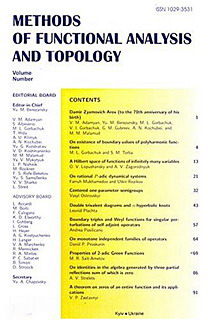Vol. 13 (2007), no. 4
A description of characters on the infinite wreath product
MFAT 13 (2007), no. 4, 301-317
301-317
Let $\mathfrak{S}_\infty$ be the infinity permutation group and $\Gamma$ an arbitrary group. Then $\mathfrak{S}_\infty$ admits a natural action on $\Gamma^\infty$ by automorphisms, so one can form a semidirect product $\Gamma^\infty \times \mathfrak{S}_\infty$, known as the wreath product $\Gamma\wr\mathfrak{S}_\infty$ of $\Gamma$ by $\mathfrak{S}_{\infty}$. We obtain a full description of unitary $I\!I_1-$factor-representations of $\Gamma\wr\mathfrak{S}_\infty$ in terms of finite characters of $\Gamma$. Our approach is based on extending Okounkov's classification method for admissible representations of $\mathfrak{S}_\infty\times\mathfrak{S}_\infty$. Also, we discuss certain examples of representations of type $I\!I\!I$, where the modular operator of Tomita-Takesaki expresses naturally by the asymptotic operators, which are important in the theory of characters of $\mathfrak{S}_\infty$.
Operator-valued integral of vector-function and bases
MFAT 13 (2007), no. 4, 318-328
318-328
In the present paper we are going to introduce an operator-valued integral of a square modulus weakly integrable mappings the ranges of which are Hilbert spaces, as bounded operators. Then, we shall show that each operator-valued integrable mapping of the index set of an orthonormal basis of a Hilbert space $H$ into $H$ can be written as a multiple of a sum of three orthonormal bases.
On holomorphic solutions of the heat equation with a Volterra operator coefficient
Sergey Gefter, Anna Vershynina
MFAT 13 (2007), no. 4, 329-332
329-332
Let $A$ be a bounded operator on a Hilbert space and $g$ a vector-valued function, which is holomorphic in a neighborhood of zero. The question about existence of holomorphic solutions of the Cauchy problem $\left\{ \begin{array}{ll} \displaystyle\frac{\partial u}{\partial t}= A\displaystyle\frac{\partial^{2}u}{\partial x^2}\\ u(0,x)=g(x) \\ \end{array} \right.$ is considered in the paper.
Generalized selfadjoinness of differentiation operator on weight Hilbert spases
MFAT 13 (2007), no. 4, 333-337
333-337
We consider examples of operators that act in some Hilbert rigging from positive Hilbert space into the negative one. For the first derivative operator we investigate a ``generalized'' selfadjointness in the sense of weight Hilbert riggings of the spaces $L^2([0,1])$ and $L^2(\mathbb{R})$. We will show that an example of the operator $i \frac{d}{dt}$ in some rigging scales, which is selfadjoint in usual case and not generalized selfadjoint, can not be constructed.
On an extended stochastic integral and the Wick calculus on the connected with the generalized Meixner measure Kondratiev-type spaces
MFAT 13 (2007), no. 4, 338-379
338-379
We introduce an extended stochastic integral and construct elements of the Wick calculus on the Kondratiev-type spaces of regular and nonregular gene alized functions, study the interconnection between the extended stochastic integration and the Wick calculus, and consider examples of stochastic equations with Wick-type nonlinearity. Our researches are based on the general approach that covers the Gaussian, Poissonian, Gamma, Pascal and Meixner analyses.
Another form of separation axioms
S. Athisaya Ponmani, M. Lellis Thivagar
MFAT 13 (2007), no. 4, 380-385
380-385
It is the object of this paper to introduce the $(1, 2)^*$pre-$D_k$ axioms for $k$ = $0$, $1$, $2$.
Development of the Markov moment problem approach in the optimal control theory
S. Yu. Ignatovich, G. M. Sklyar
MFAT 13 (2007), no. 4, 386-400
386-400
The paper is a survey of the main ideas and results on using of the Markov moment problem method in the optimal control theory. It contains a version of the presentation of the Markov moment approach to the time-optimal control theory, linear and nonlinear.


